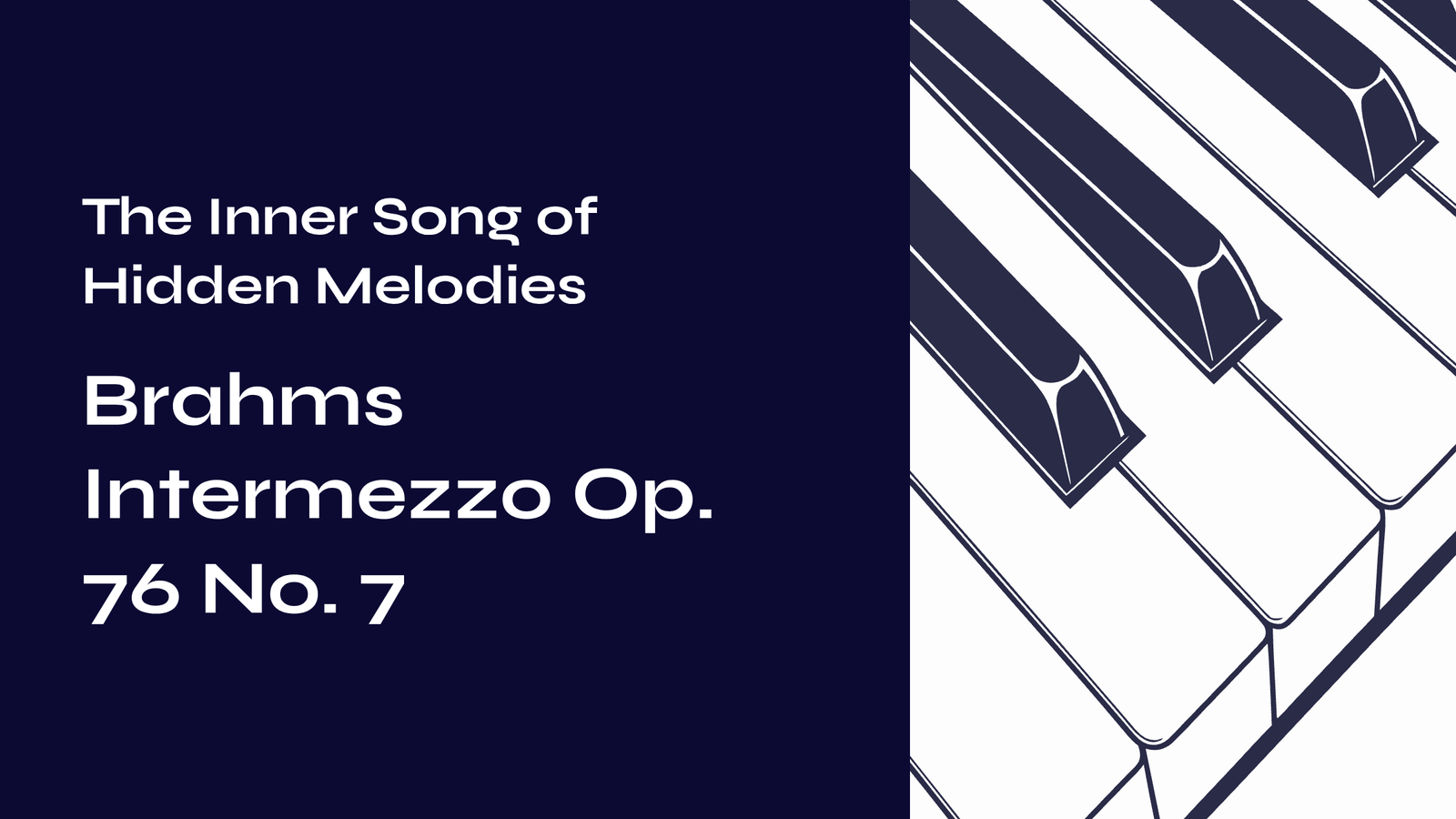Table of Contents
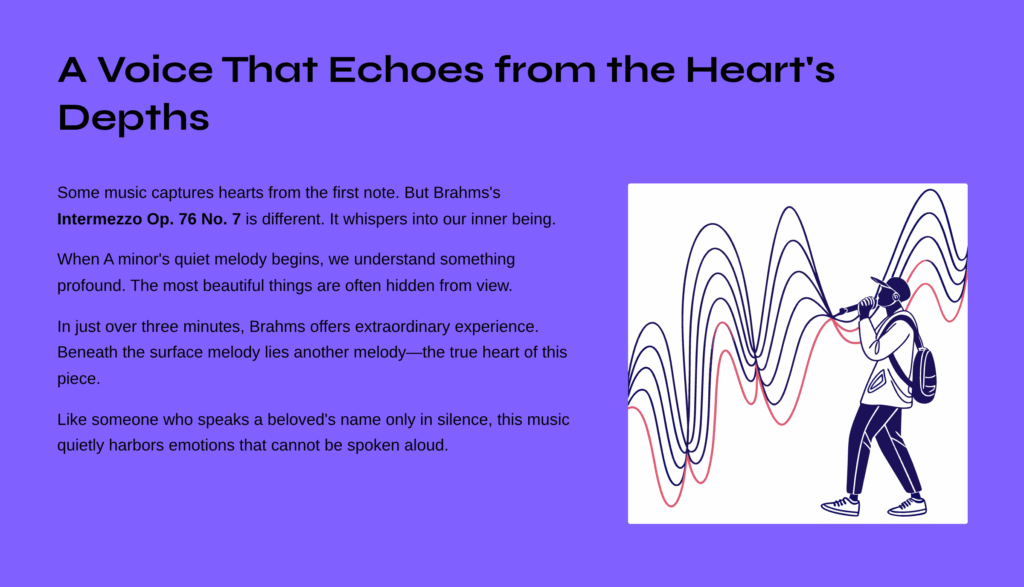
A Voice That Echoes from the Heart’s Depths
Some music captures our hearts from the very first note. But Brahms’s Intermezzo Op. 76 No. 7 is different. This piece doesn’t announce itself on the surface; instead, it whispers its way into our inner being. The moment A minor’s quiet melody begins to flow, we understand something profound: the most beautiful things are often hidden from view.
In just over three minutes, Brahms offers us an extraordinary experience. Beneath the melody we hear on the surface lies another melody, and that hidden voice is the true heart of this piece. Like someone who speaks a beloved’s name only in the silence of their heart, this music quietly harbors emotions that cannot be spoken aloud.
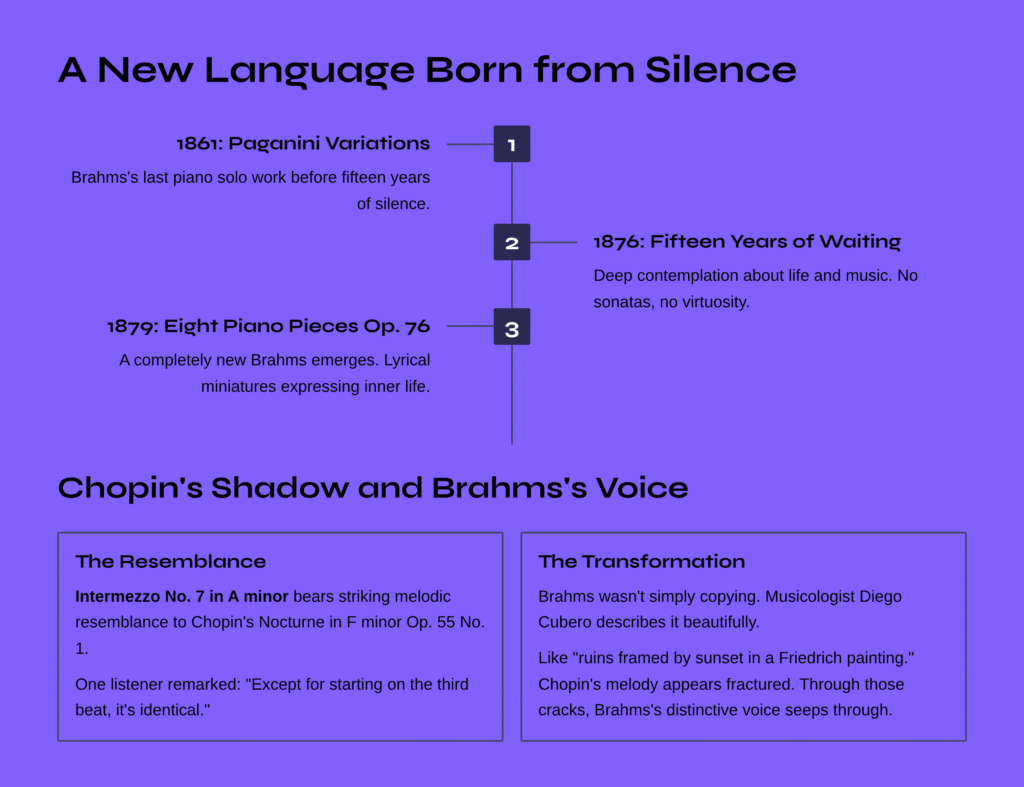
A New Language Born from Silence
The Miracle of Fifteen Years of Waiting
After the Paganini Variations Op. 35 in 1861, Brahms didn’t write a single piano solo work for an astonishing fifteen years. When the silence was finally broken in 1879 with the Eight Piano Pieces Op. 76, it revealed a completely new Brahms. No longer did he pursue the grandeur of sonatas or the brilliant virtuosity of variations. Instead, he turned toward a world of lyrical miniatures that honestly expressed his inner life.
This transformation wasn’t merely a shift in compositional technique. It was the result of deep contemplation about life and music by Brahms in his mid-forties. Rather than showcasing structural beauty or displaying technical prowess, he wanted to capture beauty as he felt it, unadorned and true.
Chopin’s Shadow and Brahms’s Voice
When you listen to the Intermezzo No. 7 in A minor, you might think, “Haven’t I heard this somewhere before?” You’re absolutely right. This piece bears a striking melodic resemblance to Chopin’s Nocturne in F minor Op. 55 No. 1. One listener remarked that “except for starting on the third beat, it’s identical to Chopin’s famous nocturne.”
But Brahms wasn’t simply copying. As musicologist Diego Cubero beautifully describes it, this piece is like “ruins framed by sunset in a Friedrich painting, where the remnants of Chopin’s nocturne surround a disappearing middle section.” Chopin’s melody appears fractured, and through those cracks, Brahms’s own distinctive voice seeps through.
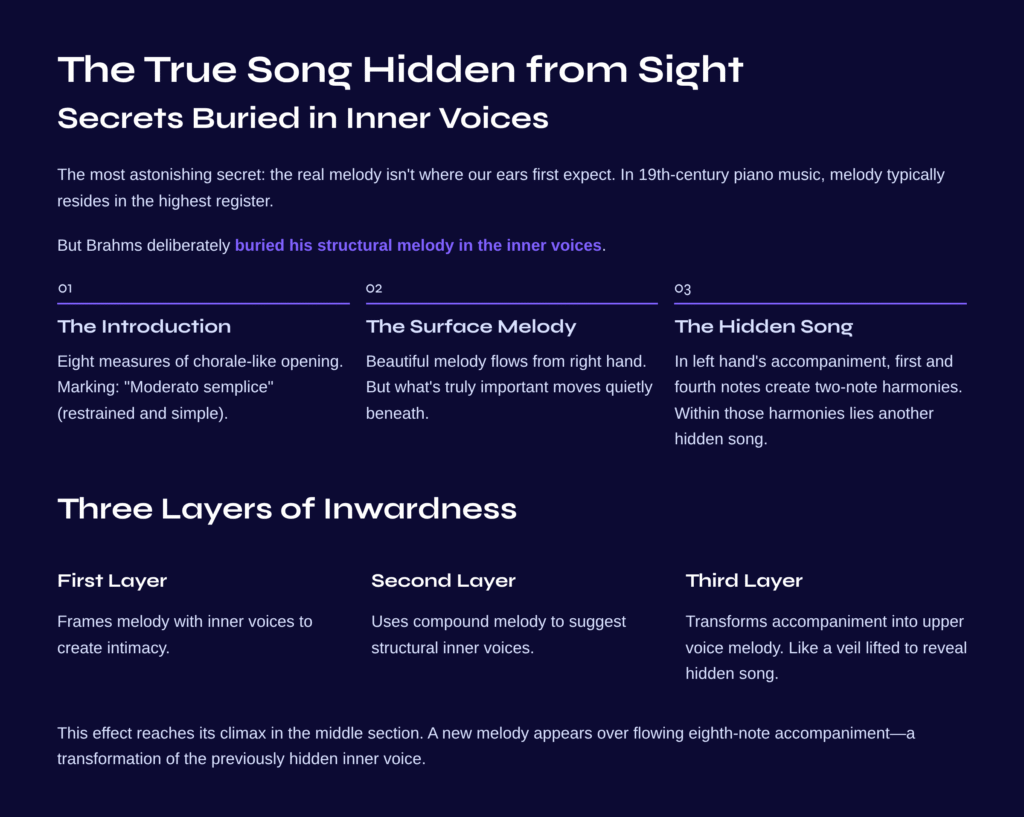
The True Song Hidden from Sight
Secrets Buried in Inner Voices
The most astonishing secret of this Intermezzo is that the real melody isn’t where our ears first expect to find it. In 19th-century piano music, melody typically resides in the highest register—the top line of the right hand. But Brahms deliberately buried his structural melody in the inner voices.
Listen carefully to this piece, which begins with the marking “Moderato semplice” (restrained and simple). After the first eight measures of chorale-like introduction, a beautiful melody flows from the right hand. But what’s truly important is the inner voice melody moving quietly beneath. In the left hand’s accompaniment pattern, the first and fourth notes create two-note harmonies—and within those harmonies lies another hidden song.
Three Layers of Inwardness
In this brief piece, Brahms employs inner voices in three different ways. First, he frames melody with inner voices to create intimacy. Second, he uses compound melody to suggest structural inner voices. Third, he transforms accompaniment inner voices into upper voice melody, as if a veil is being lifted to reveal the hidden song.
This effect reaches its climax in the middle section. A new melody appears over flowing eighth-note accompaniment—a transformation of the previously hidden inner voice. It’s like a story long kept only in the heart finally finding its way to spoken words.

Depth Blooming Through Emotional Restraint
Inheriting Schumann’s Inwardness
This piece carries the “Innigkeit” (inwardness) that Schumann pursued. But unlike Schumann’s passionate and sometimes frenzied expression, Brahms’s inwardness is quiet and restrained. A melancholy beauty woven from nostalgia, tranquility, and existential contemplation forms this piece’s emotional foundation.
Brahms’s late piano works don’t easily reveal mood through obvious melodies. Instead, they convey subtle emotions and their depths directly to the listener. This Intermezzo does the same. With neither excess nor deficiency, it captures the sadness of having a name one desperately wants to call out but cannot voice.
The Arch-Form Journey of A-B-C-B-A
Looking at this piece’s structure, we find Brahms unusually employing an arch form. Beginning with a chorale-like introduction, passing through a lyrical middle section, and returning to a quiet conclusion—it’s like a meditation process that journeys inward before returning to reality.
Particularly noteworthy is the modulation from A minor to B major. This brief moment of brightness is like sunlight suddenly breaking through clouds. But it quickly returns to A minor’s contemplative atmosphere. Such tonal changes capture the subtle shifts of human emotion with remarkable sensitivity.

How to Listen with Your Heart
First Listening: Feel the Overall Flow
When you first encounter this piece, don’t approach it analytically. Simply sit quietly and follow the music as it unfolds. It’s enough to feel how the quiet chorale theme transforms into flowing accompaniment and returns to peaceful conclusion.
During this brief journey of about 3 minutes and 45 seconds, Brahms guides us ever deeper into our inner selves. There’s an intimacy like writing alone in a diary in a quiet room.
Second Listening: Searching for Hidden Melodies
On your second hearing, focus your ears more intently. Search for the inner voice moving beneath the beautiful surface melody. You’ll discover that the left hand’s accompaniment isn’t merely background—it carries its own melodic line.
Pay special attention to how the right and left hands dialogue with each other in the middle section. Sometimes the left hand’s melody seems more important than the right’s.
Third Listening: Dialogue with Chopin
First listen to Chopin’s Nocturne in F minor Op. 55 No. 1, then return to this Brahms Intermezzo. You’ll enjoy discovering similarities and differences between them. You can feel how Chopin’s elegant, salon-style beauty was transformed by Brahms into something more inward and philosophical.
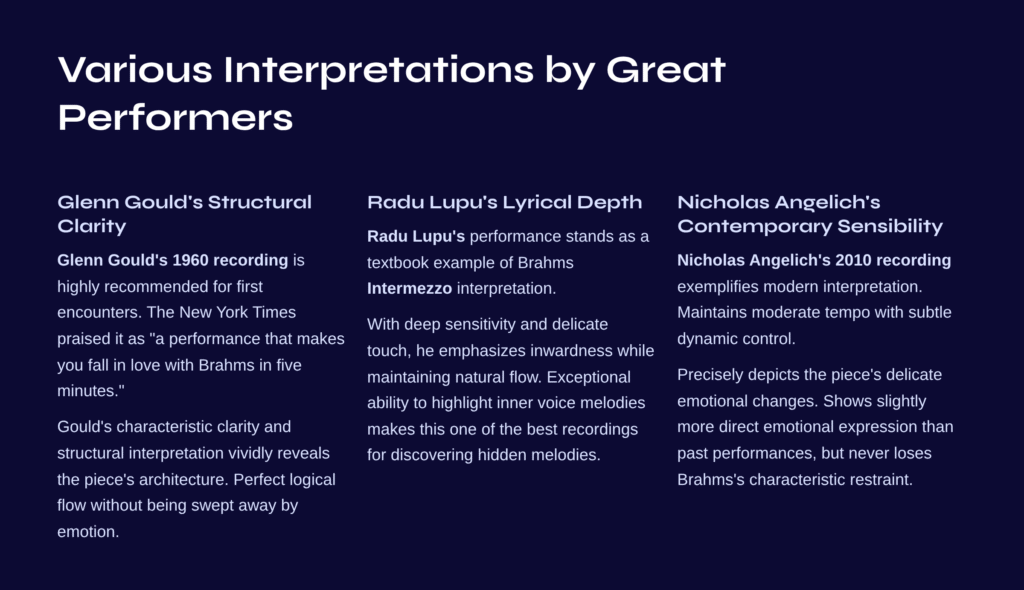
Various Interpretations by Great Performers
Glenn Gould’s Structural Clarity
Glenn Gould’s 1960 recording is highly recommended for those encountering this piece for the first time. As The New York Times praised it as “a performance that makes you fall in love with Brahms in five minutes,” Gould’s characteristic clarity and structural interpretation vividly reveals the piece’s architecture. It’s a performance that shows the music’s logical flow perfectly without being swept away by emotion.
Radu Lupu’s Lyrical Depth
Radu Lupu’s performance stands as a textbook example of Brahms Intermezzo interpretation. With deep sensitivity and delicate touch, he emphasizes inwardness while maintaining natural flow. His exceptional ability to highlight inner voice melodies makes this one of the best recordings for discovering hidden melodies.
Nicholas Angelich’s Contemporary Sensibility
Nicholas Angelich’s 2010 recording exemplifies modern interpretation. Maintaining a moderate tempo with subtle dynamic control, he precisely depicts the piece’s delicate emotional changes. While showing slightly more direct emotional expression than past performances, he never loses Brahms’s characteristic restraint.
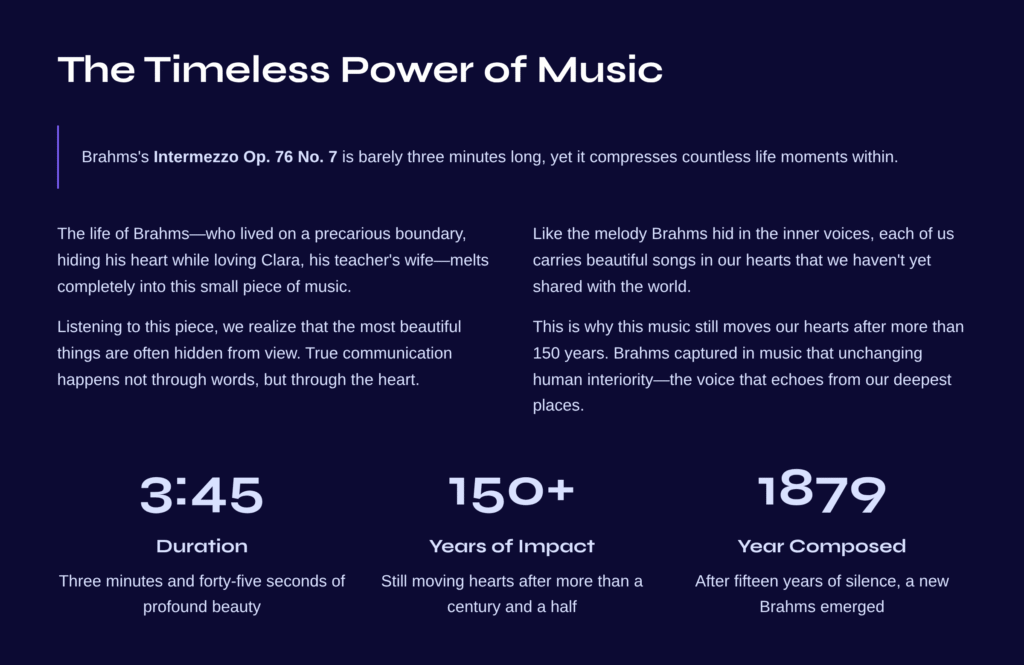
The Timeless Power of Music
Brahms’s Intermezzo Op. 76 No. 7 is barely three minutes long, yet it compresses countless life moments within. The life of Brahms—who lived on a precarious boundary, hiding his heart while loving Clara, his teacher’s wife—melts completely into this small piece of music.
Listening to this piece, we realize that the most beautiful things are often hidden from view. And that true communication happens not through words, but through the heart. Like the melody Brahms hid in the inner voices, each of us carries beautiful songs in our hearts that we haven’t yet shared with the world.
This is why this music still moves our hearts after more than 150 years. Brahms captured in music that unchanging human interiority—the voice that echoes from our deepest places, regardless of how times change.
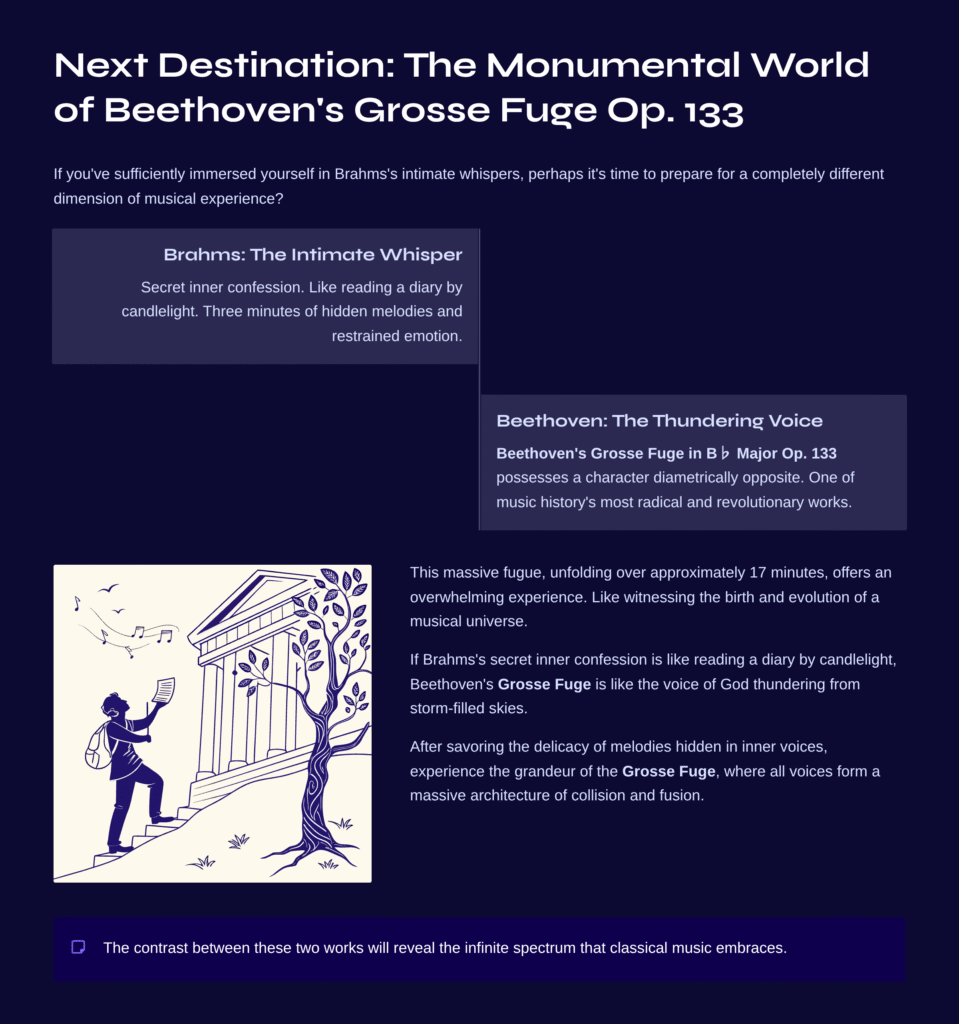
Next Destination: The Monumental World of Beethoven’s Grosse Fuge Op. 133
If you’ve sufficiently immersed yourself in Brahms’s intimate whispers, perhaps it’s time to prepare for a completely different dimension of musical experience? Beethoven’s Grosse Fuge in B♭ Major Op. 133 possesses a character diametrically opposite to Brahms’s Intermezzo.
The Grosse Fuge is one of music history’s most radical and revolutionary works, created when Beethoven transcended the limits of string quartet writing. This massive fugue, unfolding over approximately 17 minutes, offers an overwhelming experience like witnessing the birth and evolution of a musical universe. If Brahms’s secret inner confession is like reading a diary by candlelight, Beethoven’s Grosse Fuge is like the voice of God thundering from storm-filled skies.
After savoring the delicacy of melodies hidden in inner voices, experience the grandeur of the Grosse Fuge, where all voices form a massive architecture of collision and fusion. The contrast between these two works will reveal the infinite spectrum that classical music embraces.
